Didyma in Greece is a small, traditional village located in Ermionida Municipality in the Argolida region of the Peloponnese.
Famous for its tulips and caves (or dolines), Didyma (Δίδυμα in Greek) is frequented by people camping or RVing in the area, passing motorcycle groups, and people staying in private villas at Costa Bianca.
If you’re travelling to or from places like Porto Cheli, Ermioni or Koilada, to Nafplio, Epidauraus, Korinth or even further afield like Athens, be sure to turn off the main road, following the signs for Didyma and come and experience a true authentic Greek village with all it’s delights.
Andy and I have called this hidden gem in the Peloponnese home for over four years after following a crazy whim to move here from Cambodia during COVID to buy and renovate an old stone house.
Since living here we’ve discovered many reasons to visit Didyma, especially if you like getting off the beaten track like us! So, let me tell you about our charming Greek village and why you should pay it (and us) a visit.
Affiliate Link Disclosure: This post contains affiliate links. If you use them to make a purchase, we may earn a small commission at no extra cost to you. As an Amazon Associate, we earn from qualifying purchases. Learn more in our Affiliate Link Disclosure.
Reasons to Visit Didyma
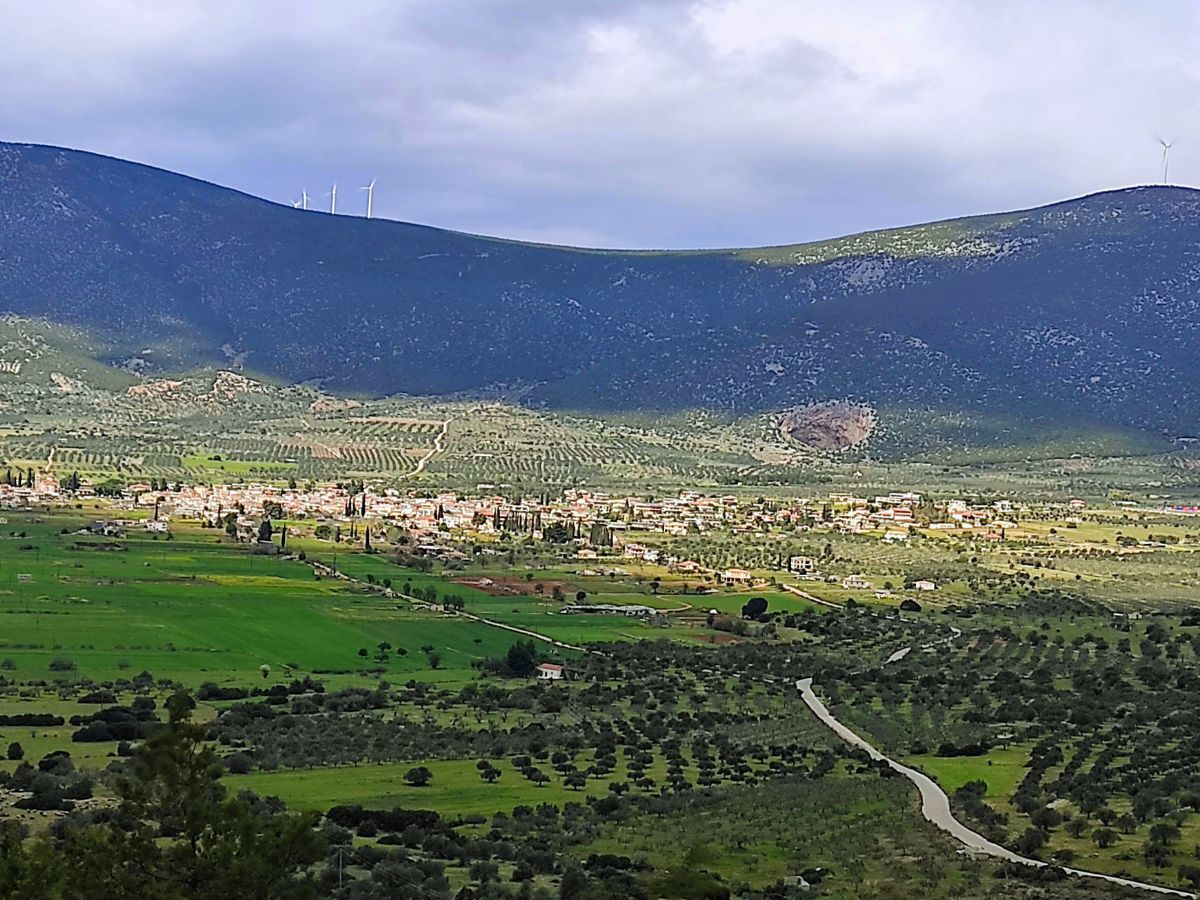
Surrounded by mountains in a fertile valley of olive groves, and fields and hillsides full of grazing goats and sheep, Didyma is about as rural as you can get.
Its name ‘Didyma’ or ‘Didima’ as it can also be spelt, means ‘Twins’ in Greek, and has two likely origins. It could be from the two mountains that rise above the village (Mount Didyma to the northeast, and Mount or Profitis Ilias to the west), or from the two caves on the outskirts.
Olive cultivation and olive oil production is an important livelihood for many villagers. Dairy products, poultry, eggs and local wine are also produced, sold, or exchanged here or in neighbouring villages.
| What You’ll Find in Didyma | ||
| Shops | Food and Drink | Other Services |
| Supermarkets | Taverna | Petrol/ Gas Station |
| Butchers | Souvlaki Joint | Mechanics |
| Bakeries | Cafes | Hairdressers |
| Fruit and Vegetable Shop | Bars | Metalworks |
| Cake/ Sweet Shop | ||
| Hardware Store | ||
| Pharmacy | ||
Didyma is certainly not on the radar for most people exploring the Peloponnese, but it should be!
Here are our top 11 reasons to visit Didyma during your trip to the Peloponnese.
1. The Didyma Caves (Dolines)
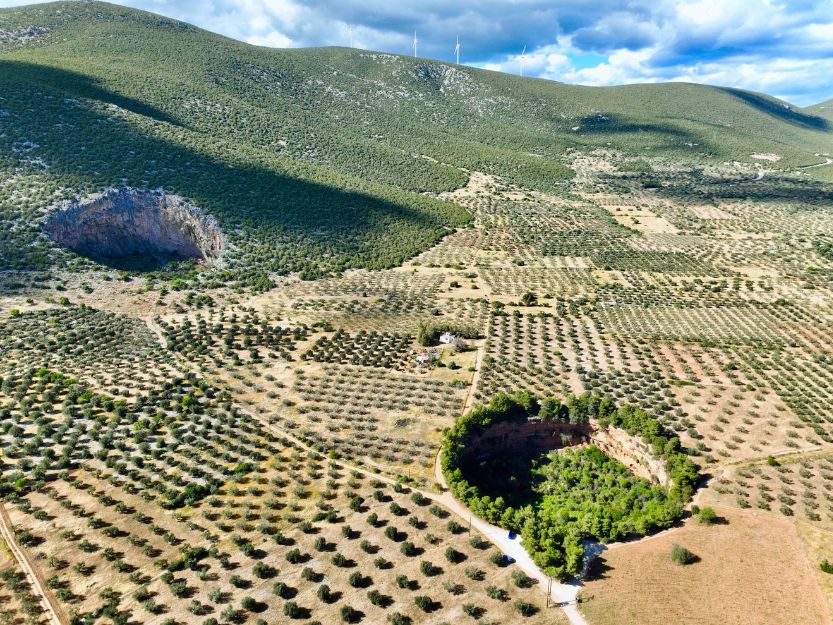
Photo Credit: Peter Kwast from Villa Hylas
The first of our reasons to visit Didyma is an attraction that only a few people living nearby will have heard of. Didyma Caves, or more specifically Didyma Megali and Mikri Spilia (Big and Small Cave), are amazing geological phenomenons that are well worth exploring.
These unique crater-like natural formations aren’t actually caves but dolines, or sinkholes. They are depressions in the ground caused by the collapse of the surface layer.
Both caves are roughly the same diameter and are within easy walking distance of the village. It’s also possible to drive to the small cave and nearly up to the big cave, although you’ll have to walk the last bit as the ground becomes very rocky.
Didyma Small Cave
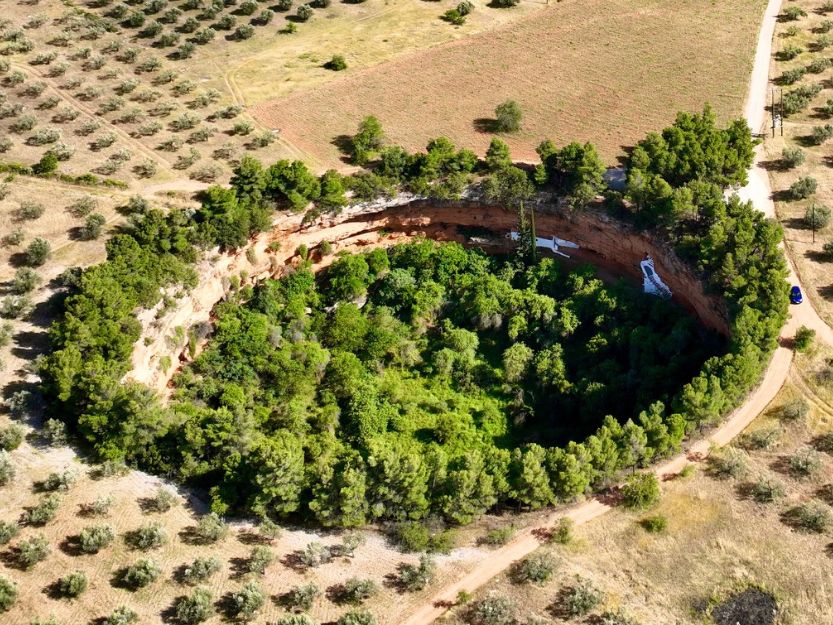
Photo Credit: Peter Kwast from Villa Hylas
The first cave is Didyma Small Cave, although it can’t be seen from the road as it’s below ground level and surrounded by trees. The entrance is via a tunnel and steps carved down through the rocks. What we find especially interesting is that the trees and vegetation inside are completely different from those outside.
Two white Byzantine churches are carved into the walls of the small cave. The Church of Saint George with its 13th Century murals is to the right, and to the left is the Church of Transfiguration (Metamorfosis). You can look inside the churches but remember to close the doors as you leave.
It’s thought that villagers once used this cave to shelter from raiding Turks and Pirates; and from German and Italian troops during World War Two.
If you’re feeling brave, it’s possible to walk around the perimeter, just be careful of the uneven ground and watch out for falling rocks.
Didyma Big Cave
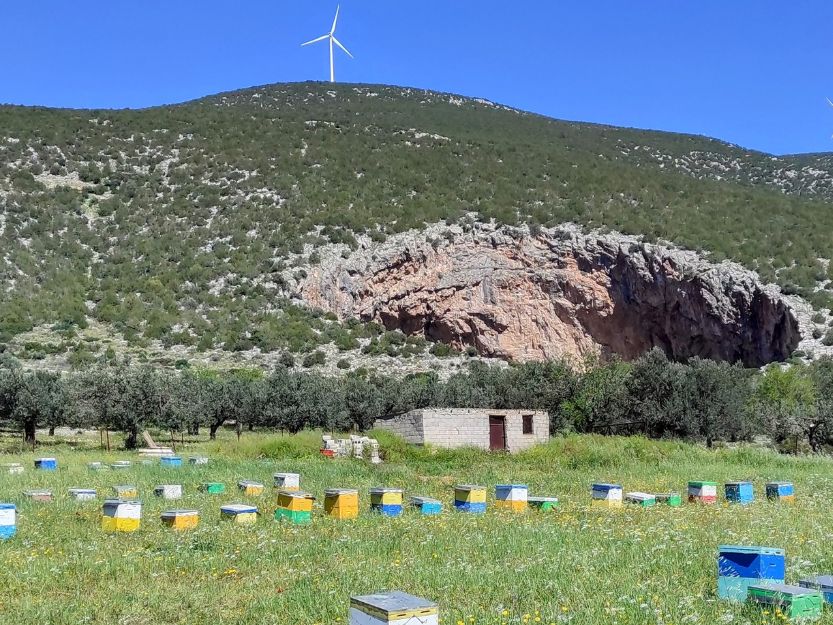
Didyma Big Cave is sunken into the mountainside and makes a striking feature on the landscape, visible clearly from the main road. It’s a few hundred metres further up the trail than the small cave and if you want to go inside you need to be prepared to scramble up, over and down the rocks and boulders. If you do this be very careful as many of the rocks are loose, making it easy to lose your footing.
Although there are no churches in this cave, it’s still impressive due to the towering walls that are home to many species of birds and bats. At the right time of year (which I must keep secret), an abundance of wild oregano grows around the edges of the crater. Andy and I harvest it with our village friend, then dry it to use in salads and other Greek dishes.
Didyma Caves are a hidden gem in their own right, that shouldn’t be missed.
2. Authentic Greek Village Life
You can’t get any more traditionally (rural) Greek than Didyma village. If you have the time, I highly recommend spending a couple of days there to experience authentic Greek village life.
And, for a small village of only around 900 people, it has a surprising amount going on.
In the village centre and the maze of little streets that surround it, you’ll discover a taverna, a souvlaki joint, cafes, bars, bakeries, supermarkets, a pharmacy, butchers, hairdressers, a fruit and vegetable store, a hardware store, a mechanics and more.
As you explore, you’ll see locals engaged in their daily routines, exchanging pleasantries (and sometimes food); there’s a real sense of community spirit.
How busy the village is and what’s going on depends on the time of day and the season.
Mornings come alive with the smell of coffee as locals enjoy a coffee in Twins Cafe, especially during the summer. Then, between 2 pm and 5 pm, it’s siesta (or in Greek ‘messimeri’), with mini-markets closing temporarily. By late afternoon it livens up a little again as residents drop into the cafe/bars and taverna for an after-work coffee or drink.
In the winter, the evenings in the village tend to be very quiet, but as soon as the weather warms up the late evenings around the centre can get lively. This is especially true when it’s public or school holidays (3 months from June to September) when the younger families who now live elsewhere return to visit parents and grandparents in the village.
Another interesting time to be in Didyma is during the olive harvest from November until January. Many locals have olive groves and the village centre is full of life in the late afternoon as they meet to discuss and compare their harvest – who got the most oil (green gold) per kilo of olives? Park yourself in the village square and witness the lively conversations going on.
While English is spoken in Didyma to varying degrees, do your best to try a few Greek phrases – the effort will go a long way. Although saying that, I know how difficult it is; we’ve been here 3.5 years now, and although we can understand a lot now, holding a conversation is still a real struggle.
3. Traditional Greek Food and Drink
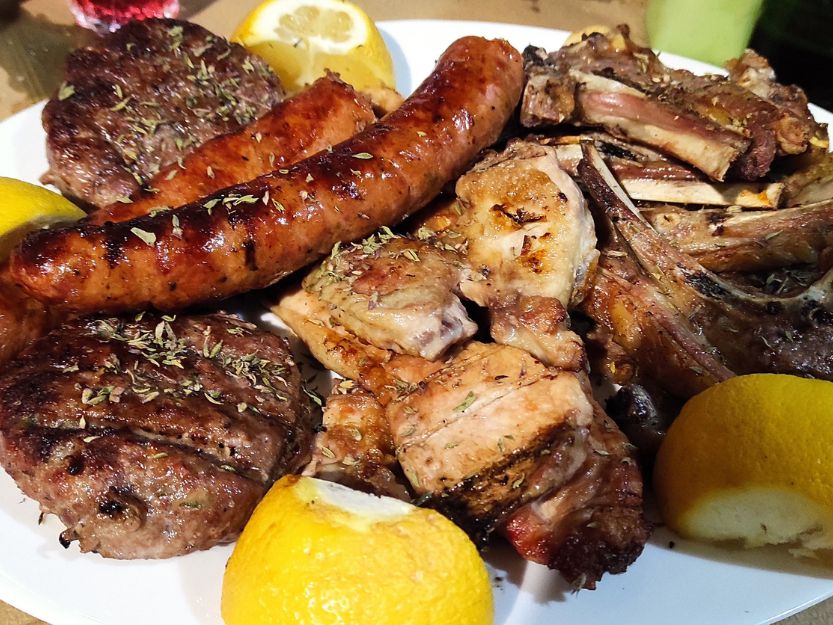
If you’re feeling hungry or thirsty whilst you’re in Didyma, there are various options depending on what you’re looking for. Just don’t expect to find a menu anywhere, it’s just not a thing. You either need to ‘be in the know’ of what’s served where, or you need to ask.
First up, you really must head to the friendly family-run Barbeque Tavern Maria for a truly delicious traditional home-cooked Greek meal.
Ask what’s cooking that day and I promise you won’t be disappointed. We often go here together and with friends. Our favourites are the grilled lamb chops and platters of other grilled meats, accompanied by fried potatoes, Greek salad, and other meze dishes. This is a great choice if there’s a group of you, but be sure to call ahead so they know how many to cook for.
If you just want something quick, your best bet is to drop into Souvlatzidiko Platanos for a tasty souvlaki pita or pizza.
For an early morning coffee, or late afternoon drink head to Twins Cafe in the centre, where you can sit in the shade under the plane trees enjoying your drink and watching the world go by.
The terrace of Aggelos Cafe is also a nice spot for a drink in the sun. If you’re peckish, and you ask, they’ll make you a huge filled roll, or pikalias (mixed variety meze plates). An added plus point, is they have a very well-stocked English-style pub bar, which is unusual for many Greek villages where the main alcoholic drinks served are often limited to beer, local wine, ouzo or tsiporo.
If you fancy a late-night drink, then Aggelos Cafe and Zemo Cafe/Bar are the places to go – especially on the weekends.
Finally on the main road on the outskirts of Didyma is the big taverna ‘To Petrino‘. Here they offer tasty traditional Greek food and although it’s sometimes used for events like weddings and christenings it doesn’t seem to get busy at other times. I’d recommend calling in advance to double-check availability and ensure they have enough food.
4. Entertainment
If you fancy something more lively than just food and a couple of drinks, Twins Cafe and Zemo occasionally host live traditional Greek music nights. These are popular with locals and visitors from nearby villages and towns.
If you’re a football fan, you could even join the locals watching the Poseidon Didymon players at the local pitch, near the petrol station. They normally play at weekends or on Wednesdays.
Sporting fixtures are also usually screened on the big screens in Twins Cafe and Aggelos Cafe.
If you time it right you may even experience the huge Poseidon Didymon event held at the football ground in July or August, which people come from all around to attend. There’s food, Greek music and singers and dancing from 10 pm until the early hours.
Check the Poseidon Didymon Facebook page for details on football matches and their summer event.
5. The Famous Didyma Tulips
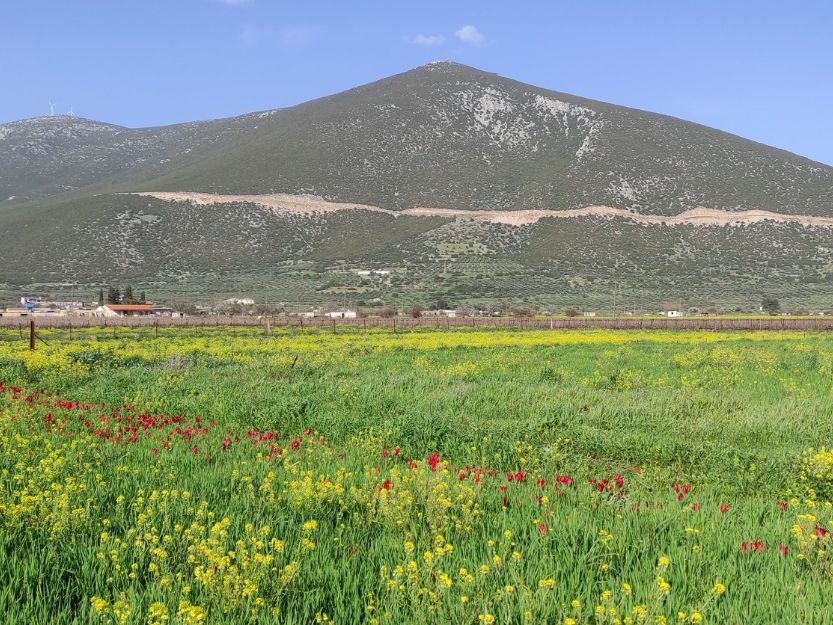
Aside from its caves, Didyma is also famous for its native wild tulips.
In Spring a rare species of wild tulip (Tulipa Undulatifolia) emerges from the fields surrounding Didyma. This small, dark red tulip is thought to be the most beautiful of the nine species of wild tulip that grow in Greece.
Endless fields of these pretty red tulips, against a backdrop of green grass and other wildflowers, create a beautiful landscape for a couple of weeks around the end of March and start of April. Passers-by often stop to go into the fields to pick armfuls of the tulips.
Didyma is so proud of its tulips, that it even holds an annual tulip festival, more about that next.
6. Didyma Tulip Festival
Every Spring, the village of Didyma in Greece comes alive with the colours and festivities of the Didyma Tulip Festival. This fun festival is held in the main square and has been an annual event since 1962. The village is transformed into a lively outdoor taverna where traditional Greek culture is showcased through music, folk dancing, and games and competitions organised by local children.
In days gone by, the Tulip Festival used to take place on a weekend during April to coincide with the tulip harvest, and the village would be adorned with wild tulips.
However, these days the festival usually takes place on the Monday after Pascha (Greek Orthodox Easter), or sometimes the following Monday. It was moved to enable local eateries to grill and sell mountains of Souvlaki (pork and chicken skewers), which hadn’t happened before as the old festival fell during Lent. In 2024 it was held on 6th May.
Sadly this does mean that the festival is usually held when the tulips have finished for the year. So, although there are no real wild tulips on display, children from the local schools make up for it by making tulip decorations to decorate the village square and streets.
Visitors come to Didyma Tulip Festival from towns and villages all around Argolidas. In 2023 and 2024 we estimated that the festival increased the village population from 900 to around 2,500 for the day.
With live music and Greek dancing until late, it’s an unforgettable experience for those who attend and one of the most important days of the year for Didyma.
7. Agios Nikolaos Church
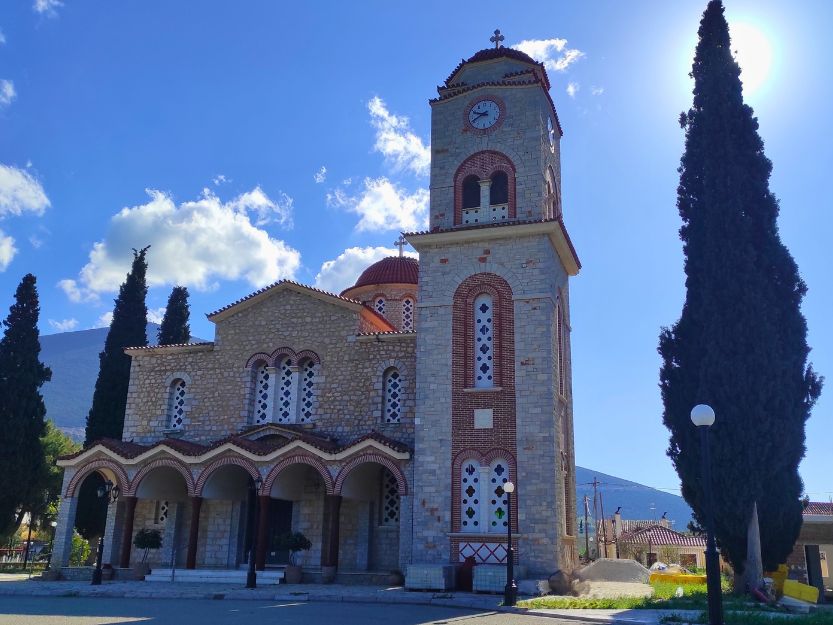
Like most Greek villages you’ll find several churches and chapels in and around Didyma. The biggest and most notable of these is Agios Nikolaos.
The beautiful church of Agios Nikolaos dominates Didyma village. It’s built on the ruins of an ancient temple of Poseidon, which indicates the area once had a higher population than it does now.
The church is a central part of village life, attended regularly by many locals. During religious festivals such as Pascha and Christmas, it gets so busy that people spill out into the grounds. They listen to the service from outside whilst they catch up with family and friends.
If visiting churches is your thing, then Agios Nikolaos is worth a look while you’re in the area.
8. Didyma Folklore Museum
The Folklore Museum of Didyma was founded in 2013 and operates voluntarily, and as far as I’m aware, only in the summer months. Now, I’m going to be completely honest that we still haven’t managed to visit, I know, I know that’s terrible but I’m yet to spend a whole Greek summer here, and when we’ve been available and when it’s been open, just haven’t coincided.
However, I’m making it my mission to go there when it’s next open this summer, so I’ll update the post with my experience then.
In the meantime, Visit Ermionida has more information on Didyma Folklore Museum.
9. Didyma Mountain and Climbing Crag
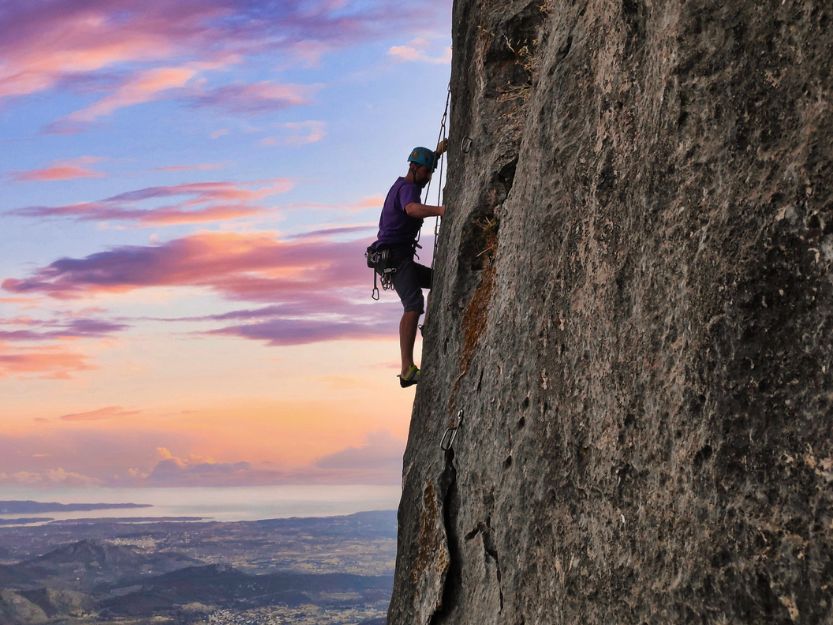
Photo Credit: Climb Ermionida
To one side of Didyma, towering above the village is Mount Didyma, standing at 1100 metres high.
If you’re brave enough to tackle the winding road to the top the views over the Argolic Gulf on a clear day are breathtaking.
At the top of Didyma is Didyma Crag, one of the top sports climbing crags in Greece. Along with many other climbing routes in Ermionida, Didyma crag was initially discovered and bolted in the 2000’s by British climber James Titt, and German Inge Zaczek.
More recently, the local climbing community Climb Ermionida has carried out maintenance on Didyma Crag and others in the region. They’ve placed several new high-quality anchors and made huge progress in revitalizing climbing activities in the area. Check out the Climb Ermionida and Olympus Mountaineering websites for more useful information about Didyma and other climbing in Ermionida and Greece.
10. Countryside and Mountain Hikes
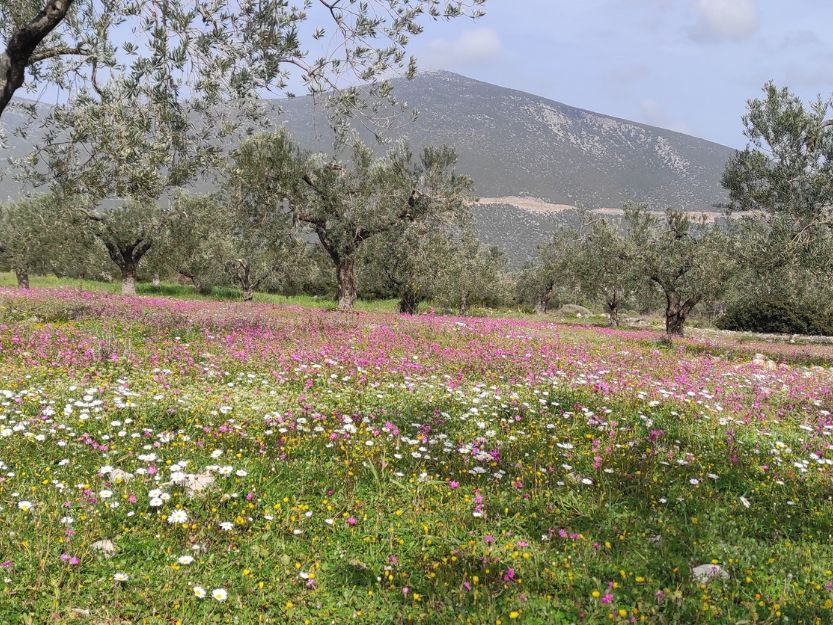
Living here in Didyma, one of my favourite pastimes is hiking in the surrounding countryside, through olive groves and vineyards and scrambling up the mountains and hills. There aren’t any official trails here exactly, it’s more a case of following the goat trails and access trails for the wind turbines. However, if you don’t go too far it’s difficult to get lost – try to stay on the trails as the hills and mountainside can get very steep, very quickly, with loose rocky ground with prickly undergrowth.
It’s important to remember that the peak summer months from June to September get VERY hot, so it’s not a good time to go hiking unless it’s for a short distance early in the morning or just before dusk. In my opinion, Spring, when all the wildflowers are out; and Autumn during the olive harvest are the best times to hike here.
Although it’s generally ok to hike on the trails through the olive groves, you do need to be careful to stay out of fenced-off land. Also, keep an ear open for goat and sheep bells – if you hear or see them, I’d recommend giving the flock a wide berth as the Greek sheepdogs are very protective of their flocks and may be aggressive. Having said that, although I am very wary of the dogs, I’ve not actually been attacked thankfully, just subjected to a lot of noisy barking.
If you prefer to follow better marked hiking trails you can find short routes at nearby Koilada and Franchti Cave and longer ones from Iliokastro to Fourni and from Fourni through Katafyki Gorge.
11. Proximity to Beautiful Salanti Beach
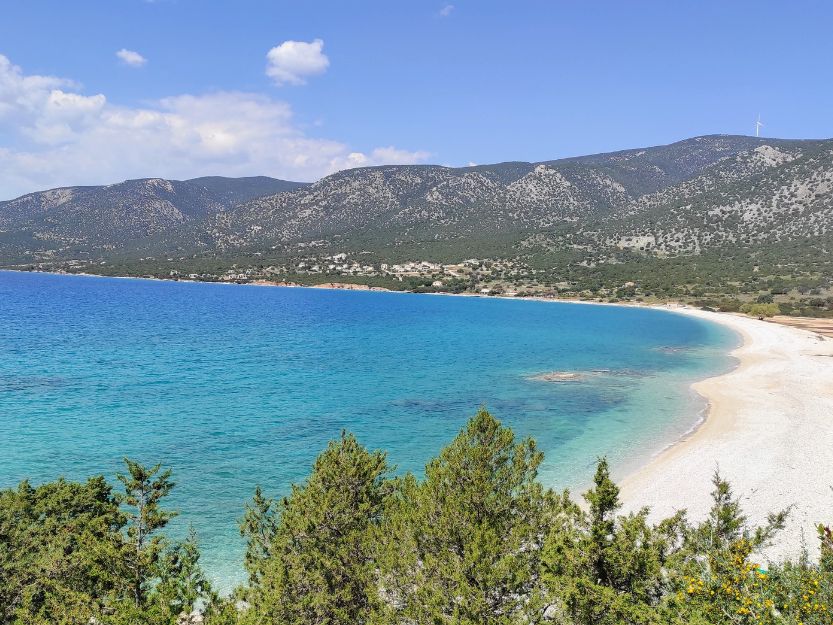
We were in two minds about sharing this with you, we selfishly wanted to keep it the hidden gem that it is. But, we’ve decided to be generous, so last but certainly not least, the last of our reasons to visit Didyma, is that it’s very close to Salanti Beach, one of the most beautiful (almost deserted) beaches in the Ermionida area.
With a pebble beach, crystal clear turquoise water, and a backdrop of mountains, you would expect Salanti Beach to be crowded with sunbeds, parasols and beachbars. But this just isn’t the case.
This sweeping bay remains unspoilt, visited only by locals in the know and a few passing travellers and tourists who find it by accident.
The water is gorgeous and calm, perfect for swimming and snorkelling. The small pebbles are also pretty comfy for laying on and relaxing, without the inconvenience of sand. One thing to bear in mind though is there is absolutely nothing there, no facilities at all, so remember to bring your own umbrellas for shade, water and food. Water shoes are also a good idea as there are occasionally sea urchins at either end of the beach near the rocks.
Just behind the beach is the derelict Salanti Hotel, once a nudist hotel, that urban explorers would find interesting to poke around in. If you fancy a walk, head around to the left of the beach (as you face the sea) to the next bay and Paralia Lakkes.
A short drive to the right of the beach is Costa Bianca Taverna, which is lovely for a drink and food but is only open for a short time each summer.
Salanti Beach also doubles as a free campsite, so if you’re camping or RVing at Salanti Beach, you’ll find Didyma, is the closest place to stock up on supplies. Just remember the shops usually shut for siesta between 2 pm and 5 pm – but then open again until about 9 pm.
There’s also a petrol station on the main road just past the village if you need to refuel.
Where to Stay in Didyma
If you have a car to explore the Argolidas part of the Peloponnese but prefer a quiet stay in a traditional Greek Village, then Didyma could be the perfect base for a few days.
There are few holiday rentals in Didyma, but the only one we have personal experience is Aspa’s Traditional house. Located right in the village centre, this was where we stayed for a week when we first arrived whilst we decided if we wanted to buy our house in Didyma. We enjoyed staying there and would recommend it, although it’s best suited for a couple or small family as it has one double room and a sofa bed.
BOOK ASPA'S TRADITIONAL HOUSE HERE
The other holiday rentals are also located in or just outside the village and can be booked via Airbnb, Booking[.com] or Vrbo.
If you’d prefer to stay outside the village and visit on a day trip, I highly recommend Villa Hylas in Kilada (adults only). Alternately here are several lovely accommodation options a bit further afield in Ermioni including Philoxenia Ganossis, Zoe Pension and Grand Bleu; or Rozos in Porto Cheli
If you prefer some extra high-end luxury check out Nikki Beach, AKS Hinitsa Bay or Amanzoe near Porto Cheli
And then, as I mentioned above, for those of you with campervans and caravans, you can always set up camp on the stunning Salanti beach.
How to Get to Didyma
Didyma has to be reached by road as it’s inland, so ideally, you’ll need your own transport. You could taxi or bus here (although buses are few and far between), but then you’d be pretty stranded.
We recommend you rent a car when you arrive in Greece and then drive to Didyma. Alternatively, get a ferry to Ermioni and then rent a car from Pop’s Car when you arrive there.
If you’re sailing you could dock in Ermioni, Porto Cheli or Kilada and then rent a car or taxi
Didyma really is a little-known, hidden Greek gem, well worth a visit on your road trip in the Peloponnese.
And, if you do find yourself out this way – be sure to look us up and drop us a message, we’d love to meet up for a coffee or a drink and a chat whilst you’re here.
Have I convinced you that Didyma is worth a visit? If so what would you like to experience most here?
Planning Your Trip to the Didyma?
Planning your trip to Didyma in the Peloponnese in Greece? Here are some of our recommended useful resources to help you have the best time possible.
|
● TRAVEL INSURANCE IS AN IMPORTANT CONSIDERATION! World Nomads offers cover for travellers in over 100 countries and True Traveller is a great option if you’re from the UK or EU. SafetyWing is another solution, particularly for digital nomads and long-term travellers. ● Use Wise (formerly Transferwise) for sending or receiving money internationally. It’s cheap, easy and transparent. ● Find amazing flight deals on Skyscanner and Kayak. ● For great prices on ferries check out Ferryhopper. ● Compare charter yacht hire prices on Click&Boat. ● Compare rental car prices on Rentalcars.com. ● You can book train, bus and other ground transportation with Trainline, 12Go and Bookaway. ● Booking.com and Expedia usually have the best hotel prices. ● Our go-to for self-catering accommodation is Vrbo. ● Discover fantastic trips and activities with Viator and GetYourGuide. ● Check out Bookmundi, G Adventures, and Intrepid Travel for group holidays and tours. |
Read More Greece5 Unique Things to Do in Laconia12 Things to Know Before Going to Santorini 7 Reasons to Visit Leonidio in Greece |
Enjoy this post? Pin it for later!
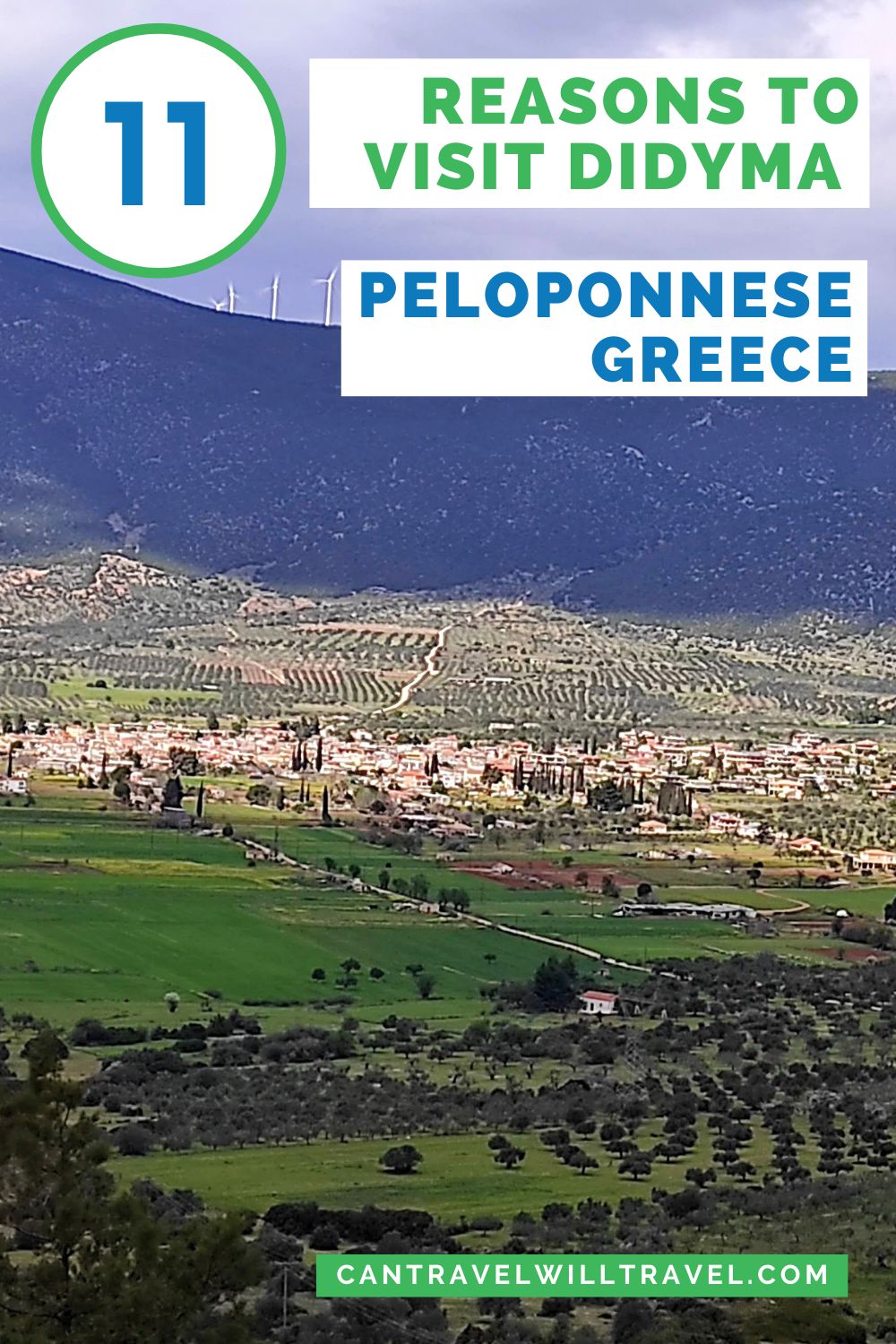

Hi, Sorry no we didn’t see an email from you, sorry!
We were sad to leave too – however there are lots of other English speakers in the area of Porto Cheli, Ermioni and Kilada. Many from Holland, England, and also Sweden, Germany and Australia.
There are lots of lovely people in the area to meet with and socialise 🙂
Good luck if you move there. I’m sure you’d love it.
Take Care
Tanya
Hi
We just watched your you tube video re selling your place in Didyma.
Did you manage to get it sold? (We might be interested!)
Good luck with your move back to England.
Hi Heather,
We have had an offer on the house for €130,000. However until a deposit has been paid (as is standard in Greece), the house is still on the market.
Please do drop us an email if you’d like more info.
Thankyou Tanya & Andy
Hello Tanya can you see my mail? What a pitty that you are moving. I am looking for a house around porto heli and actually plan to visit shortly to see a few options. I have watched your videos and was so happy at least some english speakers would be around, but now you are moving hm that makes me think twice too. Anyway if you see my mail please will you reply to me by mail? Many thanks